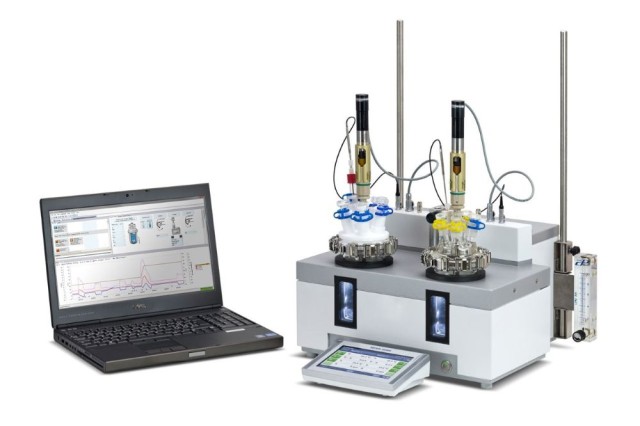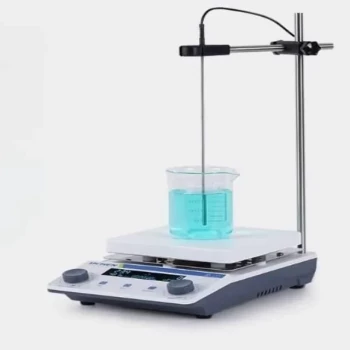Hochdruck-Reaktoren
Anwendungen
Hochdruckreaktoren sind unverzichtbare Hilfsmittel in der chemischen Forschung, vor allem wenn es um extreme Bedingungen geht. Diese speziellen Reaktoren sind so konzipiert, dass sie chemischen Reaktionen bei hohen Temperaturen und hohem Druck standhalten und diese ermöglichen. Sie sind daher ideal für den Umgang mit Materialien, die erhebliche Risiken bergen.
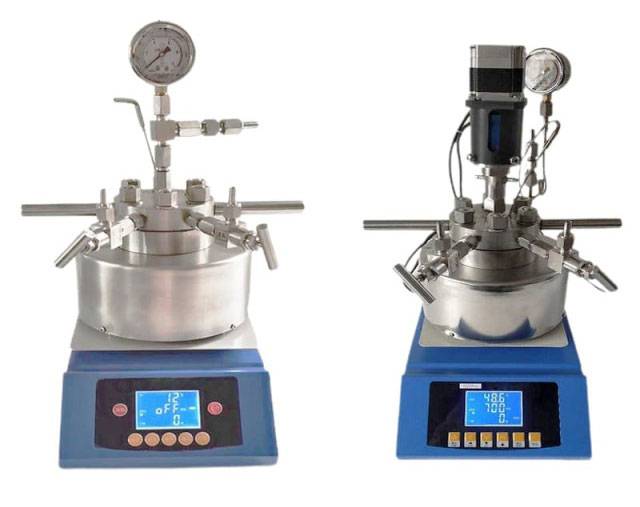
Hochdruckreaktoren sind vor allem für Experimente mit brennbaren, explosiven und giftigen Medien von entscheidender Bedeutung. Ihre robuste Konstruktion gewährleistet Sicherheit und Effizienz und ermöglicht es den Forschern, diese gefährlichen Substanzen zu manipulieren, ohne die Integrität der Experimente zu gefährden. Diese Fähigkeit ist besonders wertvoll in Branchen wie der Petrochemie, der Pharmazie und der Spezialchemie, wo eine präzise Kontrolle der Reaktionsbedingungen von größter Bedeutung ist.
Darüber hinaus geht die Vielseitigkeit von Hochdruckreaktoren über die Sicherheit hinaus. Sie sind für eine Vielzahl von chemischen Prozessen geeignet, von einfach bis komplex, und ermöglichen so ein breites Spektrum von Anwendungen. Ob es um die Synthese neuer Verbindungen, die Optimierung von Reaktionswegen oder die Untersuchung der Reaktionskinetik geht, Hochdruckreaktoren bieten die notwendige Umgebung, um die gewünschten Ergebnisse zu erzielen.
Zusammenfassend lässt sich sagen, dass Hochdruckreaktoren nicht nur Werkzeuge sind, sondern wesentliche Komponenten für den Fortschritt in der chemischen Forschung und bei industriellen Prozessen. Sie bieten sowohl Sicherheit als auch Funktionalität in den schwierigsten Umgebungen.
Glas-Reaktoren
Funktionalität
Glasreaktoren sind mit einer doppelschichtigen Glaskonstruktion ausgestattet, die für die Handhabung einer Vielzahl von Reaktionsmaterialien entscheidend ist. Diese einzigartige Konstruktion ermöglicht einen vielseitigen Betrieb, einschließlich Rühren unter normalen und negativen Druckbedingungen. Das doppelschichtige Glas bietet nicht nur Transparenz zur Überwachung der Reaktionen, sondern sorgt auch für eine stabile Umgebung, indem es eine konstante Temperaturregelung ermöglicht. Dies wird durch die Integration von Heiz- und Kühlsystemen erreicht, die eine präzise Temperaturregelung während des gesamten Reaktionsprozesses ermöglichen.
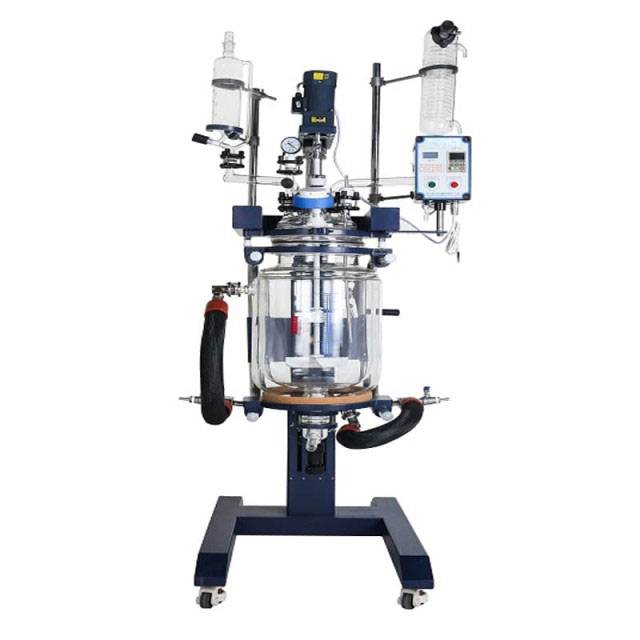
Neben der Temperaturkontrolle bietet die doppelschichtige Glaskonstruktion auch verbesserte Sicherheitsmerkmale. Die äußere Glasschicht dient als Schutzbarriere, die das Risiko eines versehentlichen Kontakts mit gefährlichen Stoffen verringert. Diese Konstruktion ist besonders vorteilhaft, wenn mit empfindlichen oder flüchtigen Stoffen gearbeitet wird, da sie die Gefahr des Auslaufens und Verschüttens minimiert.
Die Funktionalität von Glasreaktoren geht über das einfache Rühren und die Temperaturkontrolle hinaus. Sie sind auch mit fortschrittlichen Funktionen wie automatischer Druckregelung und programmierbaren Steuersystemen ausgestattet. Diese Funktionen ermöglichen es Forschern, komplexe Reaktionen mit hoher Präzision und Reproduzierbarkeit durchzuführen, was Glasreaktoren zu einem unverzichtbaren Werkzeug in modernen Labors macht.
Magnetische Reaktoren
Dichtungsmechanismus
Magnetische Reaktoren verfügen über eine ausgeklügelte statische Dichtungsstruktur, in die ein magnetischer Koppler integriert ist. Diese Konstruktion ist ausschlaggebend für die Verringerung von Leckageproblemen und gewährleistet somit eine vollständig abgedichtete Arbeitsumgebung. Die Magnetkupplung fungiert als berührungslose Übertragungsvorrichtung, die die Übertragung von Drehmoment und Bewegung ohne direkten physischen Kontakt ermöglicht. Diese Eigenschaft ist besonders vorteilhaft beim Umgang mit gefährlichen Materialien, bei denen selbst kleinste Leckagen die experimentelle Integrität und Sicherheit gefährden können.
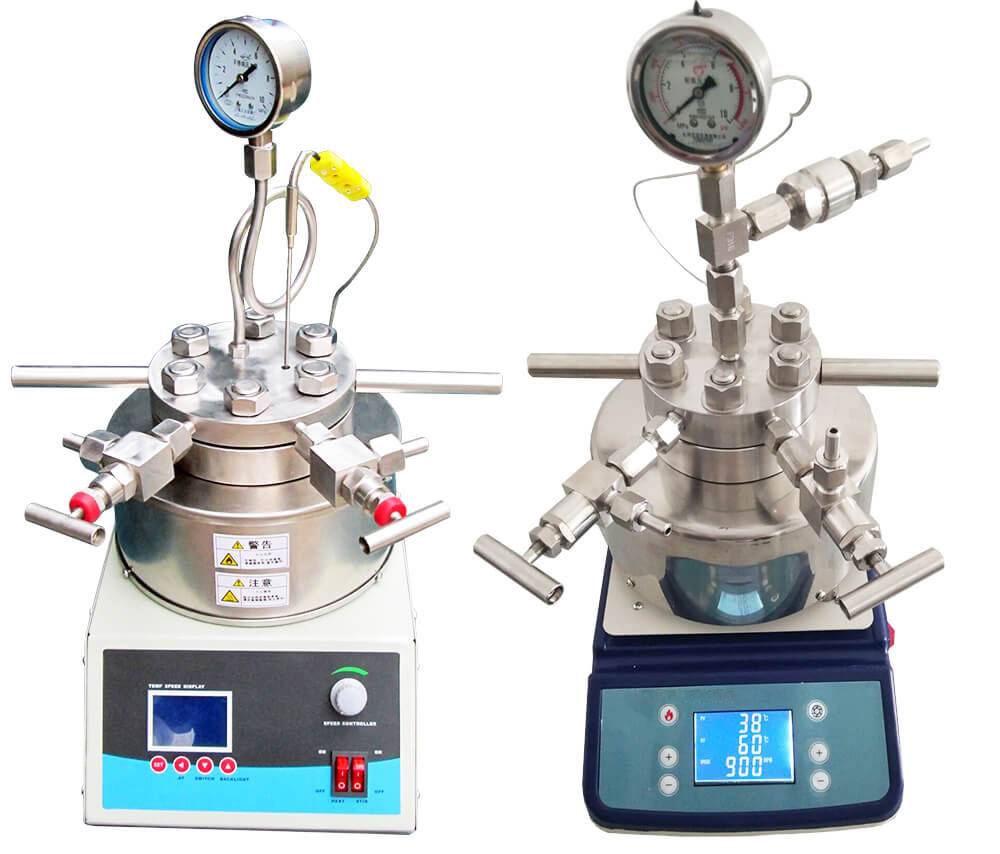
Der statische Dichtungsmechanismus funktioniert nach dem Prinzip von Magnetfeldern, die mit den internen Komponenten des Reaktors interagieren und einen reibungslosen Betrieb ohne mechanische Dichtungen ermöglichen. Dieser Ansatz erhöht nicht nur die Haltbarkeit des Reaktors, sondern vereinfacht auch die Wartungsarbeiten. Da der häufige Austausch von Dichtungen entfällt, werden die Gesamtbetriebskosten gesenkt, was Magnetreaktoren zu einer kosteneffizienten Wahl für Labors macht.
Darüber hinaus gewährleistet die vollständige Versiegelung, dass die Reaktionsumgebung unberührt bleibt und keine externen Verunreinigungen eindringen, die die Reaktionsergebnisse verändern könnten. Dieses Maß an Umgebungskontrolle ist entscheidend für Experimente, die präzise Bedingungen erfordern, wie z. B. Experimente mit toxischen oder explosiven Medien. Die Effizienz des Magnetkopplers bei der Aufrechterhaltung einer geschlossenen Umgebung unterstreicht die Eignung des Reaktors für anspruchsvolle Forschungs- und Entwicklungsaktivitäten.
Mikrowellen-Synthesizer
Katalytische Reaktionen
Mikrowellensynthesizer spielen eine wichtige Rolle bei der Katalyse einer Vielzahl von Reaktionen in verschiedenen Bereichen, einschließlich organischer Chemie, Pharmazie und Biochemie. Diese Synthesizer nutzen die einzigartigen Eigenschaften von Mikrowellen, um die Reaktionsgeschwindigkeit und -ausbeute zu erhöhen, was sie zu unverzichtbaren Werkzeugen in modernen Labors macht.
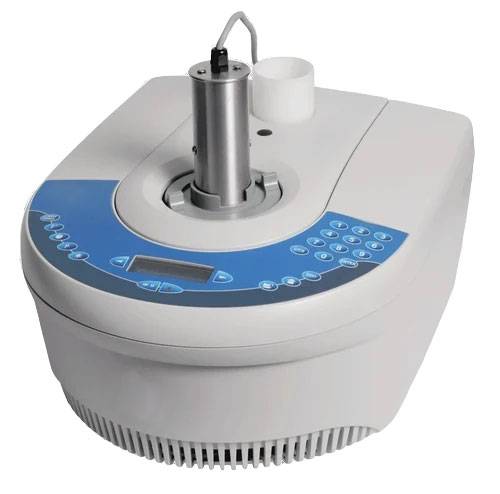
Einer der Hauptvorteile von Mikrowellensynthesizern ist ihre Fähigkeit, komplexe organische Reaktionen zu ermöglichen. Diese Reaktionen erfordern oft eine präzise Kontrolle von Temperatur und Druck, Bedingungen, die Mikrowellen effizient erfüllen können. Bei der Synthese von Arzneimitteln beispielsweise werden oft komplizierte molekulare Umwandlungen durchgeführt, die von der schnellen und gleichmäßigen Erwärmung durch Mikrowellen profitieren.
Im Bereich der Biochemie werden Mikrowellensynthesizer eingesetzt, um Reaktionen mit Biomolekülen zu katalysieren. Diese Reaktionen können aufgrund der Empfindlichkeit biologischer Materialien gegenüber Hitze und anderen Umweltfaktoren besonders schwierig sein. Die kontrollierte Erwärmung und die schnellen Reaktionszeiten, die Mikrowellen bieten, tragen dazu bei, den Abbau zu minimieren und die Produktreinheit zu maximieren.
Neben chemischen Reaktionen spielen Mikrowellensynthesizer auch bei physikalischen Prozessen wie der Lösungsmittelextraktion eine entscheidende Rolle. Diese Technik wird häufig bei der Extraktion wertvoller Verbindungen aus komplexen Gemischen eingesetzt, ein Prozess, der durch den Einsatz von Mikrowellenenergie erheblich beschleunigt und optimiert werden kann.
Zusammenfassend lässt sich sagen, dass Mikrowellensynthesizer vielseitige Werkzeuge sind, die ihre katalytischen Fähigkeiten auf ein breites Spektrum wissenschaftlicher Disziplinen ausdehnen und sowohl die Effizienz als auch die Effektivität von Forschung und Entwicklung im Labor verbessern.
Reaktionskalorimeter
Messung
Reaktionskalorimeter sind unentbehrliche Werkzeuge im Labor, um die bei chemischen Reaktionen oder physikalischen Prozessen freigesetzte oder absorbierte Wärme zu messen. Diese Messung ist von entscheidender Bedeutung für die Gewinnung von Erkenntnissen im Bereich der Thermochemie und Kinetik, die für das Verständnis der Energieänderungen und Reaktionsgeschwindigkeiten bei verschiedenen Prozessen unerlässlich sind.
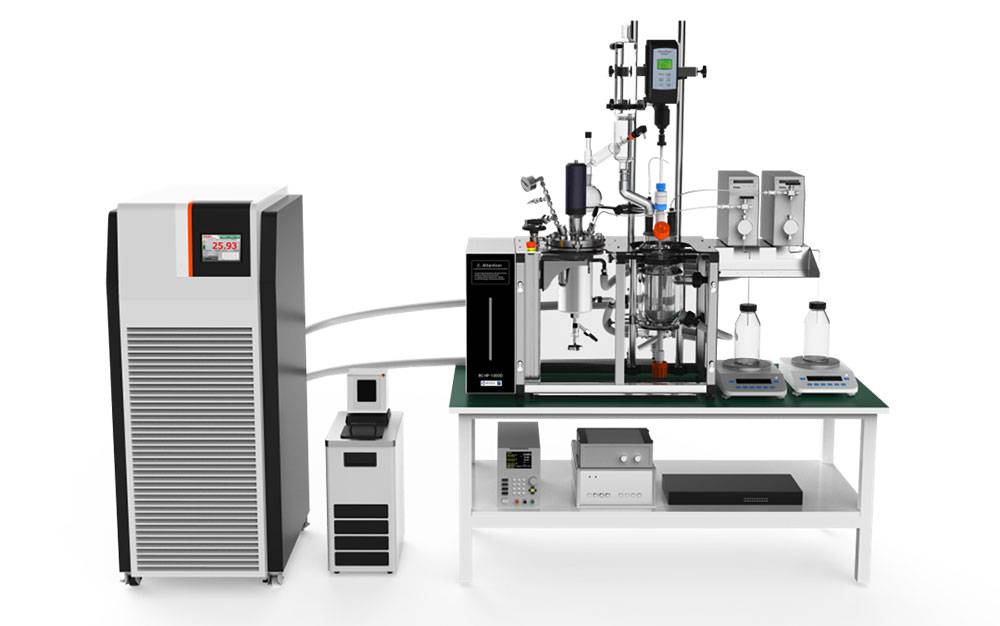
Die mit Reaktionskalorimetern gesammelten Daten können zur Analyse der thermodynamischen Eigenschaften von Reaktionen verwendet werden, wie z. B. Enthalpie- und Entropieänderungen, die für die Vorhersage von Reaktionsergebnissen und die Optimierung von Reaktionsbedingungen von grundlegender Bedeutung sind. Darüber hinaus liefern die aus diesen Messungen abgeleiteten kinetischen Parameter, wie Aktivierungsenergie und Reaktionsordnung, wertvolle Informationen für die Prozesssteuerung und das Scale-up.
| Messung Parameter | Einblick in die Thermochemie | Einblick in die Kinetik |
|---|---|---|
| Wärmefreisetzung/Absorption | Enthalpie-Änderung | Reaktionsgeschwindigkeit |
| Temperaturänderung | Entropie-Änderung | Aktivierungsenergie |
Durch die Überwachung des Wärmestroms können Forscher auch potenzielle Gefahren erkennen, wie z. B. exotherme Reaktionen, die zu Durchbruchsreaktionen oder Überhitzung führen könnten, und so sicherere Laborpraktiken gewährleisten. Die Integration kalorimetrischer Daten mit anderen Analysetechniken verbessert das Gesamtverständnis komplexer Reaktionssysteme und macht Reaktionskalorimeter zu einem wesentlichen Bestandteil der modernen chemischen Forschung und Entwicklung.
Geräte zur Katalysatorbewertung
Bewertungsprinzipien
Geräte zur Katalysatorbewertung simulieren reale Reaktionsbedingungen, um die Effizienz von Katalysatoren zu beurteilen. Diese Bewertung basiert in erster Linie auf Messwerten, die von den Reaktionsprodukten abgeleitet werden, die sorgfältig analysiert werden, um die Wirksamkeit des Katalysators zu beurteilen. Diese Bewertungsmethoden lassen sich grob in zwei Typen unterteilen: statisch und dynamisch.

Statische Bewertung beinhaltet die Einrichtung einer kontrollierten Umgebung, in der die Reaktionsbedingungen während des gesamten Experiments konstant bleiben. Diese Methode ist besonders nützlich für die Untersuchung der anfänglichen Aktivität und Selektivität von Katalysatoren unter stabilen Bedingungen. Schlüsselparameter wie Temperatur, Druck und Reaktantenkonzentrationen sind festgelegt und ermöglichen eine detaillierte Analyse der Leistung des Katalysators ohne Beeinträchtigung durch schwankende Variablen.
Dynamische Bewertung Die dynamische Evaluierung hingegen ahmt realistischere industrielle Bedingungen nach, bei denen sich die Reaktionsbedingungen ändern können. Bei diesem Ansatz wird bewertet, wie gut ein Katalysator seine Effizienz unter wechselnden Bedingungen, wie schwankenden Temperaturen oder wechselnden Reaktantenkonzentrationen, beibehalten kann. Die dynamische Bewertung ist für die Vorhersage der langfristigen Leistung und Stabilität von Katalysatoren in kontinuierlichen Prozessen von entscheidender Bedeutung und liefert Erkenntnisse, die die statische Bewertung allein nicht bieten kann.
| Bewertung Typ | Wesentliche Merkmale | Anwendung |
|---|---|---|
| Statisch | Kontrollierte, konstante Bedingungen | Studien zur anfänglichen Aktivität und Selektivität |
| Dynamisch | Variable Bedingungen | Langfristige Leistung und Stabilität in kontinuierlichen Prozessen |
Sowohl statische als auch dynamische Bewertungsmethoden sind für eine umfassende Bewertung der Katalysatoreffizienz unerlässlich, um sicherzustellen, dass der gewählte Katalysator für die spezifischen Reaktionsbedingungen, denen er in der Praxis ausgesetzt ist, optimiert ist.
Synthese-Workstations
Automatisierung
Vollautomatische Synthesereaktoren, die von fortschrittlichen Computersystemen gesteuert werden, revolutionieren den Bereich der Verbindungs- und Arzneimittelforschung. Diese hochentwickelten Maschinen bewältigen eine Vielzahl von Prozessen mit Präzision und Effizienz, einschließlich Füllen, Erhitzen, Rühren und Destillation. Die Automatisierung verbessert nicht nur die Reproduzierbarkeit und Genauigkeit von Experimenten, sondern verringert auch das Risiko menschlicher Fehler, was besonders in heiklen und anspruchsvollen Forschungsumgebungen entscheidend ist.

Einer der Hauptvorteile dieser automatisierten Systeme ist ihre Fähigkeit, komplexe Arbeitsabläufe ohne manuelle Eingriffe zu steuern. Diese Fähigkeit ist besonders vorteilhaft bei der Synthese komplizierter Verbindungen, bei denen die kleinste Abweichung zu erheblichen Abweichungen im Endprodukt führen kann. Die computergesteuerten Systeme stellen sicher, dass jeder Schritt mit den exakten, von den Forschern vordefinierten Parametern ausgeführt wird, so dass die Konsistenz über mehrere Läufe hinweg erhalten bleibt.
Außerdem ermöglicht die Automatisierung einen kontinuierlichen Betrieb, was den Forschungsprozess erheblich beschleunigen kann. Forscher können Experimente so einrichten, dass sie über Nacht oder an Wochenenden laufen, wodurch die Zeit im Labor optimal genutzt wird. Dieser kontinuierliche Betrieb wird durch die robuste Konstruktion der Reaktoren erleichtert, die so gebaut sind, dass sie über längere Zeiträume eingesetzt werden können, ohne an Leistung einzubüßen.
Zusätzlich zu ihren betrieblichen Vorteilen tragen die automatisierten Synthesereaktoren auch zur Sicherheit im Labor bei. Durch die Handhabung gefährlicher Prozesse wie Erhitzung und Destillation minimieren diese Systeme die Exposition der Forscher gegenüber potenziell gefährlichen Chemikalien und Bedingungen. Dies schützt nicht nur die Gesundheit und Sicherheit des Forschungsteams, sondern gewährleistet auch die Einhaltung der strengen Sicherheitsvorschriften für Labore.
Die Integration der Computersteuerung ermöglicht auch eine Echtzeitüberwachung und Datenaufzeichnung, die den Forschern wertvolle Einblicke in die Reaktionsdynamik gewährt. Diese Daten können genutzt werden, um die Reaktionsbedingungen zu optimieren, Ineffizienzen zu erkennen und den Syntheseprozess zu verfeinern. Die Möglichkeit, in Echtzeit zu analysieren und anzupassen, ist ein bedeutender Fortschritt, der zu effizienteren und effektiveren Forschungsergebnissen führen kann.
Zusammenfassend lässt sich sagen, dass das Aufkommen vollautomatischer Synthesereaktoren einen entscheidenden Wandel in der Art und Weise darstellt, wie Wirkstoff- und Arzneimittelforschung betrieben wird. Durch den Einsatz computergesteuerter Präzision verbessern diese Systeme die Reproduzierbarkeit, beschleunigen die Forschungszeiten, erhöhen die Sicherheit und liefern wertvolle Daten für die Prozessoptimierung. Mit der Weiterentwicklung der Technologie wird ihr Einfluss auf den Bereich der chemischen Synthese wachsen und den Weg für neue Entdeckungen und Innovationen ebnen.
Ähnliche Produkte
- Rostfreier Hochdruckreaktor
- Mini-SS-Hochdruckreaktor
- Explosionssicherer hydrothermischer Synthesereaktor
- Hydrothermischer Synthesereaktor
- Labor-Magnetrührer mit konstanter Temperatur
Ähnliche Artikel
- Isostatisches Pressen verstehen: Verfahren, Vorteile, Grenzen und Anwendungen
- 10 wesentliche Sicherheitsschritte für den Einsatz von Druckreaktoren in Laboren
- Sicherheit im Labor: Hochdruckgeräte und Reaktoren
- Sicherheit im Labor: Sichere Verwendung von Hochspannungsgeräten
- Verbesserung der Sicherheit in Ihrem Labor: Ein umfassender Leitfaden zur Sicherheit von Druckreaktoren
